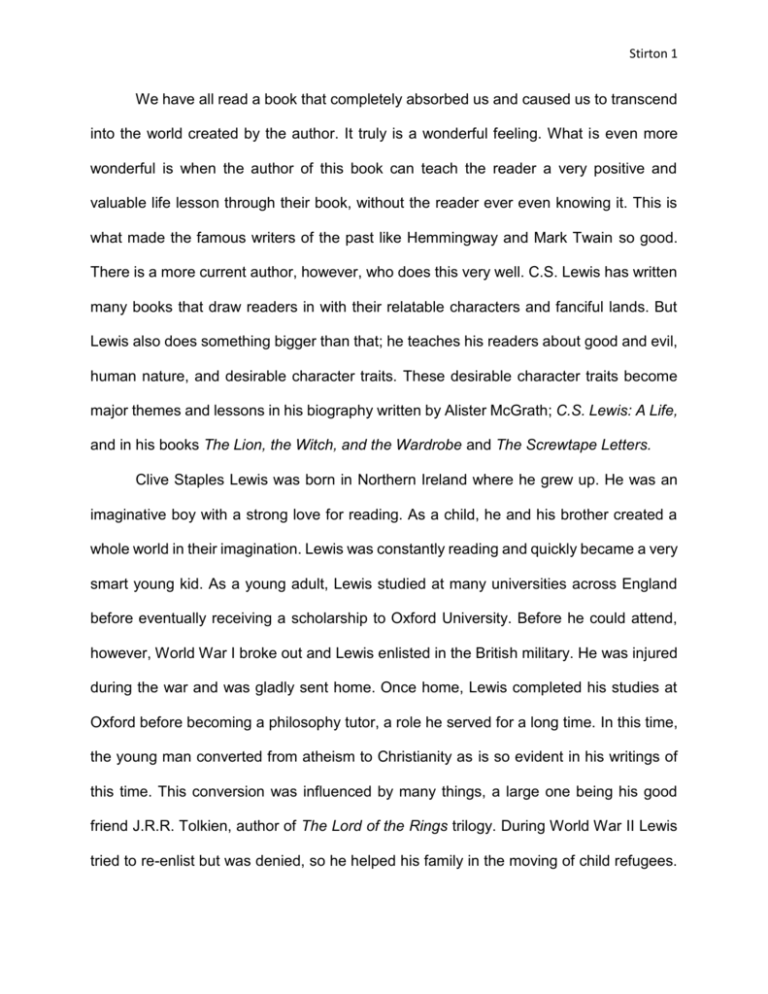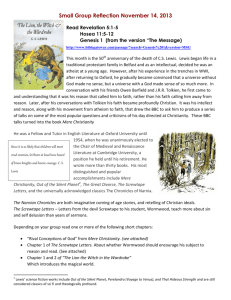Stirton We have all read a book that completely absorbed us and
advertisement

Stirton 1 We have all read a book that completely absorbed us and caused us to transcend into the world created by the author. It truly is a wonderful feeling. What is even more wonderful is when the author of this book can teach the reader a very positive and valuable life lesson through their book, without the reader ever even knowing it. This is what made the famous writers of the past like Hemmingway and Mark Twain so good. There is a more current author, however, who does this very well. C.S. Lewis has written many books that draw readers in with their relatable characters and fanciful lands. But Lewis also does something bigger than that; he teaches his readers about good and evil, human nature, and desirable character traits. These desirable character traits become major themes and lessons in his biography written by Alister McGrath; C.S. Lewis: A Life, and in his books The Lion, the Witch, and the Wardrobe and The Screwtape Letters. Clive Staples Lewis was born in Northern Ireland where he grew up. He was an imaginative boy with a strong love for reading. As a child, he and his brother created a whole world in their imagination. Lewis was constantly reading and quickly became a very smart young kid. As a young adult, Lewis studied at many universities across England before eventually receiving a scholarship to Oxford University. Before he could attend, however, World War I broke out and Lewis enlisted in the British military. He was injured during the war and was gladly sent home. Once home, Lewis completed his studies at Oxford before becoming a philosophy tutor, a role he served for a long time. In this time, the young man converted from atheism to Christianity as is so evident in his writings of this time. This conversion was influenced by many things, a large one being his good friend J.R.R. Tolkien, author of The Lord of the Rings trilogy. During World War II Lewis tried to re-enlist but was denied, so he helped his family in the moving of child refugees. Stirton 2 After WWII, he married Joy Davidman, but soon lost his wife to cancer. Shortly after, Lewis developed blood poisoning and died. “Own eyes are not enough for me, I will see through those of others. . . . In reading great literature I become a thousand men and yet remain myself. Like the night sky in the Greek poem, I see with a myriad eyes, but it is still I who see” (Lewis, C.S. Lewis: A Life). As McGrath cites Lewis in his biography, he really puts an emphasis on Lewis’ thirst for knowledge. This is a thirst that people should awaken in themselves. This desire to learn is what drove Lewis to become the legend of a man he is today. It is a character trait that should be desirable to all people and Lewis is a great example of this trait. The Lion, the Witch, and the Wardrobe is, at the surface, merely a fantastic tale about four children and a lion. The book begins with the children; Lucy, Edmund, Peter, and Susan; moving into their new home for the summer with their uncle. To the children, his house is a mansion filled with mystery and adventure. During one of these adventures Lucy, the youngest, stumbled into a large wardrobe during a game of hide and seek. She walked further and further back but eventually she found herself in a great wood. It was a magical land and it is where she met Tubmus, a delightful talking fawn, before returning home to tell the others. Of course, none of them believed her but soon Edmund, the second youngest, found his way into this magical place as well. Rather than a nice fawn, however, he met the White Witch who gave him enchanted hot chocolate and he promised to bring his siblings back to her. Soon, all of the children found their way through the wardrobe and began exploring. Eventually they met Mr. and Mrs. Beaver who were kind and took them to their dam to have dinner. While here Edmund slips away to find the White Witch and he does. The others notice he’s gone and the Beavers take the other Stirton 3 children to Aslan, the great lion who can save Narnia. The three children meet Aslan and were all taken aback by how great and powerful he seemed. In the meantime Aslan’s supporters had gone and saved Edmund. He was happy to see the others but also very ashamed and embarrassed for betraying them. That night they stayed at Aslan’s camp. Lucy and Susan had trouble sleeping that night and when they heard Aslan leaving, they decided to follow him. He walked right into the White Witch’s camp and let them kill him on a large table. When the enemies cleared out, the girls ran to him crying, but he had disappeared, leaving only a broken table. Then, out of nowhere, Aslan appeared, looking stronger than ever. He explained to the girls that he had to give his life in exchange for Edmund’s. When they returned to camp the next morning, there was a great battle being waged between Aslan’s troops and the White Witch’s. With Aslan and the girl’s help, they defeated the Whitch, and the four children took their place as kings and queens of Narnia. This book may seem like just a fanciful tale for children, but upon closer examination it is pretty easy to see that it is more than that. As Lewis writes, “Well, sir, if things are real, they are there all the time." "Are they?" said the Professor; and Peter did not quite know what to say” (Lewis, 81 The Lion, the Witch, and the Wardrobe). As with the rest of the book, Lewis is directly hinting at religion, but whether you buy into those beliefs of not, it is easy to see the lesson that can be taught here. No matter how outrageous or unsupported they are, follow your beliefs. It would have been easy for Lucy to begin doubting herself when the others did not believe in her. She could have given up on the idea and concluded that she made it all up but she stuck to it and she was right. This is exactly Lewis’ point. People may tease you and tell you that you are wrong, but Stirton 4 even if you are the only one who believes in something, stick with it, because you may be right. “"Here is your brother," he said, "and – there is no need to talk to him about what is past." Edmund shook hands with each of the others and said to each of them in turn, "I'm sorry," and everyone said "That's all right." And then everyone wanted very hard to say something which would make it quite clear that they were all friends with him again – something ordinary and natural – and of course no one could think of anything in the world to say” (Lewis, 144 The Lion, the Witch, and the Wardrobe). One of the major themes in this novel is forgiveness. It appears time and time again through the book and this is just one example. Forgiveness proves to be a valuable trait in this book. It is what separates the good guys from the bad guys and allows them to eventually win the battle. Another example of forgiveness in the book is when Aslan dies on the table for Edmund’s betrayal. This is the ultimate sacrifice and shows the highest degree of forgiveness. It is also very important that Aslan does this, because in the end it is Edmund who kills the White Witch and frees Narnia. Through these examples, Lewis encourages readers to show forgiveness. It is a trait that many story tellers overlook and do not bother to teach, but it is one that deserves teaching and Lewis does it well. The Screwtape Letters is one of the most unique and interesting books I have ever read. The story is told in the form of letters. All of the letters are sent from Screwtape, a demon who holds an administrative post in Hell, to his nephew Wormwood, an amateur tempter who is trying to get his human target, called a “patient” to fall into irresponsibility, temptations, and wrongdoing in order to eventually get the patient to Hell when he dies. All of the letters Screwtape sends are full of advice for Wormwood and also scolding if he does something Stirton 5 wrong, although there is rarely praise when he does something right. The majority of the book is filled with tips and tricks on how to defeat and combat the “enemy” (God) and how to make the patient conform to the demons’ will without him knowing that’s what he’s doing. Through Screwtape’s reactions to Wormwood’s letters, you get an idea of the choices that the patient is making. In the second letter the reader finds out that the patient has converted to Christianity and Screwtape reprimands him for this. Later in the book the reader learns that World War II has broken out. Screwtape comments that this could either help or hinder them depending on the actions that Wormwood takes. The patient joins the army and is sent to war, which, to Screwtape, is a bad thing for the demons. At the end of the book, the patient’s plane is shot down in the war and he is killed. His soul is sent to heaven, meaning that Wormwood and the demons have failed. Wormwood turns is to be severely punished, and when he turns to his uncle for help, his uncle says that he can expect just as much assistance as he would give Screwtape if their roles were reversed, referring to the time Wormwood turned in his uncle for making a religious comment to offend him. This book is a direct commentary on religion and can be viewed as a how-to guide for how to be a religious person in reverse. Even though this book is more directly linked to Christianity than The Lion, The Witch, and the Wardrobe, you can just as easily extract important lessons for anyone to learn. Lewis writes “Courage is not simply one of the virtues but the form of every virtue at the testing point, which means at the point of highest reality” (Lewis, 86 The Screwtape Letters). At this point in the book the patient is about to begin fighting in the war and Screwtape is trying to tell Wormwood how to get the patient to think. He advises him to stay away from courage at all costs, because it is one of the only values that they cannot twist to their own advantage. This shows the importance of courage to become a good person. A courageous person, according to Lewis, has the form of every virtue at the testing point. It does not matter what type of courage you show. It can be going Stirton 6 off to war, like the patient, or standing up for what you believe, or simply trying something new. No matter the courage, it will be the base for all other positive traits in your life, and Lewis teaches this lesson very well. Throughout this book Lewis continually makes the argument that being open minded is important on the journey to becoming a good person. “It is funny how mortals always picture us as putting things into their minds: in reality our best work is done by keeping things out” (Lewis, 11 The Screwtape Letters). Lewis is trying to show how close-mindedness can lead to becoming a bad person. By letting new ideas and new beliefs into one’s mind, a person grow and becomes better. Without open-mindedness we become stagnant as a person, never progressing or growing or improving. Yet another valuable lesson taught by Lewis in The Screwtape Letters. C.S. Lewis has the unique ability to write a story that seems nothing more than that. In reality, however, you cannot find one book written by him that does not teach the reader one or more valuable lessons. Whether you are looking at his life through McGrath’s C.S. Lewis: A Life, or reading one of his books such as The Lion, the Witch, and the Wardrobe or The Screwtape Letters there is always a desirable character trait to be learned. Lewis was an amazing man and his books are regarded as classics and some of the best literature of all time. Go ahead and pick one up, you may just become a better person because of it.


